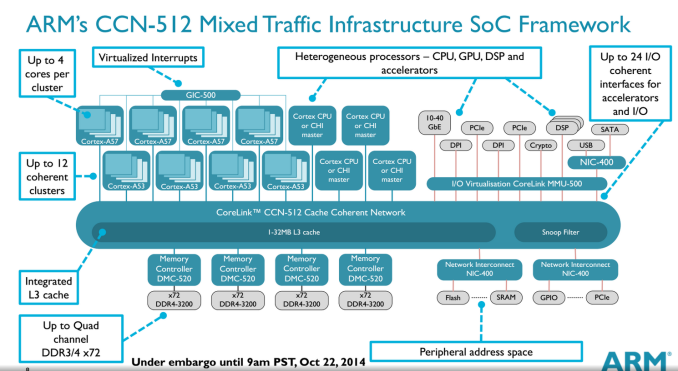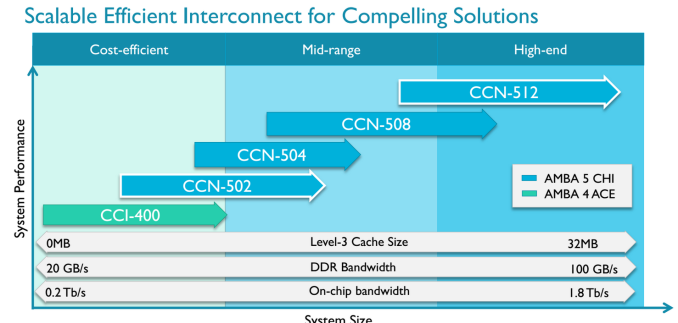ARM Challenging Intel in the Server Market: An Overview
by Johan De Gelas on December 16, 2014 10:00 AM ESTAMD Opteron A1100
The 28nm octal-core AMD Opteron A1100 is a lot more modest and aims at the low end Xeon E3s. Stephen has described the chip in more detail. To ensure a quick time to market, the AMD Opteron A1100 is made of existing building blocks already designed by ARM: the Cortex-A57 core and the Cache Coherent Network or CCN.
The AMD Opteron A1100 is one of the few vendors that uses the ARM interconnect. ARM put a lot of work into this design to enable ARM licensees to build SoCs with lots of accelerators and cores. CCN is thus a way of attaching all kinds of cores, processors, and co-processors ("accelerators") coherently to a fast crossbar, which also connects to four 64-bit memory controllers, integrated NICs, and L3 cache. CCN is very comparable to the ring bus found inside all Xeon processors beginning with "Sandy Bridge". The top model is the CCN-512 which supports up to 12 clusters of quad-cores. This could result in an SoC with 32 (8x4) A57 cores and four accelerators for example.
AMD would not tell us which CCN they are using but we suspect that it is CCN-504. The reason is this CCN was available around the time work started on the Opteron A1100 and the fact that AMD mentions the ARM bus architecture AMBA 5 in their slides. And it also makes sense: the CCN-504 supports up to 4 x 4 cores and supports the Cortex-A57.
It was rumored that the A1100 still used the CCI-400 interconnect, which is used by smartphone SoCs, but that interconnect uses the AMBA 4 architecture. Meanwhile the CCN-502 was announced in October 2014, way too late to be inside the A1100.
The AMD Opteron A1100 consists of four pairs of "standard" triple issue Cortex-A57 cores and 1MB L2 cache, with 8MB L3 cache.
The key differentiator is the cryptographic processor that can accelerate RSA (Secure Connection/hand shake) and AES (encrypting the data you send and receive) and SHA (part of the authentication). Intel uses the PCIe Quick Assist 89xx-SCC add-in card or the special Intel Communication chipset to provide a cryptographic coprocessor. These coprocessors are mostly used in professional firewalls/routers. As far as we know such cryptographic processors are of limited use in most https web services. Most modern x86 cores now support AES-NI, and these instructions are well supported. As a result, the current x86 CPUs from AMD and Intel outperform many co-processors when it comes to real world AES encoding/decoding of encrypted data streams.
A cryptographic coprocessor could still be useful for the RSA asymmetric encrypted handshake, but it remains to be seen if offloading the handshakes will really be faster than letting the CPU take care of it, as each offload operation causes all kinds of overhead (such as a system call). A cryptographic coprocessor running on the same coherent network as the main cores could be a lot more efficient than a PCIe device though. It has a lot of potential, but AMD could not give us much info on the current state of software support.














78 Comments
View All Comments
jhh - Tuesday, December 16, 2014 - link
SPARC and Power have had trouble keeping up with Moore's law, as neither sold enough to amortize R&D to push out innovation at the same rate as Intel. As Moore's law comes to an end, this will stop being a unique Intel advantage. It just might be too late for both of them. One can see the pressure on IBM, with their opening the Power architecture in similar ways to ARM. Both POWER and SPARC have to keep up to porting drivers to their Unix implementations, while the device manufacturers either write drivers for Linux or don't get volume. I just can't see either POWER or SPARC being cost effective over the long run. And, when others see the same thing, they aren't going to be excited about porting application software to those platforms.ARM needs to have a good performance/power and performance/cost ratio to get people excited to buy something other than Intel. They are certainly getting enough volume from the low-end to make investment on high-end parts. So far, I'm not excited enough to recommend any ARM proof-of-concept though.
Kevin G - Wednesday, December 17, 2014 - link
IBM always had a licensing model similar to ARM with PowerPC cores. The only thing really new here is that IBM is licensing out there flagship POWER chip in the same manner. Despite Intel having a process advantage, IBM was able to keep up in performance. (The 45 mm based 8POWER7 was generally faster than the 32 mm 10 core Westmere-EX.) There will always be a market for top performance but you are correct that sustaining on just that customer base is unwise.IBM does realize that their software licensing model to subsidize hardware R&D was not sustainable. So while you can't run AIX, you can get a POWER8 box for less than $3k now.
OreoCookie - Wednesday, December 17, 2014 - link
Really, just $3000? Wow, how times have changed, I remember ~12 years ago that a single Alpha CPU cost that much (the department I was working for had a workstation fail, fortunately under warranty, because otherwise they would have had to pay for 2 new CPUs and new RAM worth about 15,000 German Marks).Ratman6161 - Wednesday, December 17, 2014 - link
"The general lower cost of Linux and open source software" While it's true that the cost of a Linux OS including support is lower than an equivalent Windows OS, in the larger scheme of things the cost of Windows and even VMware becomes little more than background noise in the total cost of operations. Try pricing out an Oracle DB for example and you find that the cost of that software dwarfs the price of the hardware it's running on as well as whatever the OS is costing. Ditto with most "enterprise software".lefty2 - Tuesday, December 16, 2014 - link
Intel has another big advantage over ARM, which everyone seems to have forgotten about, and that is software compatibilty. 64-bit ARM server software is still a work in progress. The stuff that's being worked on at the moment is open source. Once that's finished you still have to convince clients to convert their proprietary software to ARM.JohanAnandtech - Tuesday, December 16, 2014 - link
Don't you think that the open source software that has been/is ported now is enough? Apache/PHP/MySQL, Memcached and Hadoop...that is a massive server market. And there is little stopping Microsoft to invest in ARM software too. Just VMware might be a bit tricky, but I don't think the software is a problem.Kevin G - Wednesday, December 17, 2014 - link
Actually VMware has said some less that flattering about ARM. Xen is the main hyper visor on ARM for the moment.goop666666 - Thursday, December 25, 2014 - link
Yeah, recompiling is so very hard. Essentially what you're saying is that Intel is for legacy systems and software that is poorly written. That is a large enough market, but doesn't apply to hyperscale deployments, which are the future.gostan - Tuesday, December 16, 2014 - link
great article by Johan as always.but the argument is muted. we have heard this tune before.
the hardware might be cheaper. the power bill might be cheaper. wait until you see the software maintenance cost. custom software needs 'custom' pricing.
besides, arm has no cutting edge fab process to back them.
JohanAnandtech - Tuesday, December 16, 2014 - link
You do not need expensive software to create a server market these days. Just look how many webservers are running the LAMP stack.